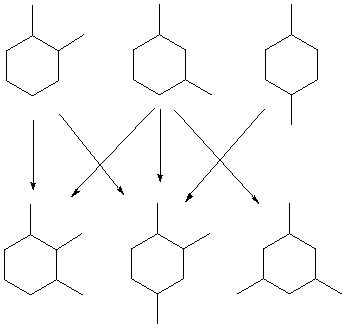
Obviously the 1,2-disubstituted isomer gives two
products; the 1,3 gives three; and the 1,4 gives only one.
This identifies both starting materials and products.
Equivalence of Positions in Benzene
Wilhelm Körner is usually remembered for the following elegant method of establishing which di- and tri-substituted isomers of benzene are which by counting product or source isomers:

Obviously the 1,2-disubstituted isomer gives two
products; the 1,3 gives three; and the 1,4 gives only one.
This identifies both starting materials and products.
Equivalence of Positions in Benzene
The above method begins with the assumption that the six carbons of benzene (or the six hydrogens attached to them) are in equivalent positions. It would not work the same if the six carbons formed a pentagonal pyramid, or a less symmetrical assembly.
Koerner published his astounding proof that the six positions are equivalent in 1869, 5 years before the van't Hoff-Le Bel hypothesis of tetrahedral carbon. In the positivist view of many established chemists geometric models of molecules were not subject to experimental test and were thus both inappropriate and insidious. Introducing his paper Koerner wrote:
The dogma of the impossibility of determining the atomic constitution of substances, which until recently was advocated with such fervor by the most able chemists, is beginning to be abandoned and forgotten; and one can predict that the day is not far in the future when a sufficient collection of facts will permit determination of the internal architecture of molecules. A series of experiments directed toward such a goal is the object of this paper.
Still, because of hte intellectual atmosphere, he
designed a proof that would be appropriate to abstract "chemical"
space rather than being limited to three-dimensional "physical"
space.
Koerner's only assumptions were those which are indispensable when using chemical transformations in structure proof:
(1) direct replacement
(2) experimental distinguishability
In 1867 he had stated these assumptions as follows:
If one grants that in simple transformation the new substituent assumes the position of the element displacedººmost of the demonstrations are based on establishing the identity or difference of several substances of the same composition, but obtained by different reactionsº
The first assumption, that
chemical locations persist through reaction, is reminiscent of the
type theory. The second is only plausible when the experimenter's
skill and the chemical and physical methods used are adequate to
distinguish different substances. Körner's passion for preparing
samples in a state of extreme purity and for testing them
exhaustively is evident in his published work and is legendary. In
applying this assumption to macroscopic experimental results one must
assume further that pure substances are composed of identical
molecules, so that problems from inseparable mixtures (such as
racemates) do not arise.
Körner used only the following five sets of experimental observations in his proof:
(A) There are three distinct isomers of hydroxybenzoic acid. These are salicylic acid, "hydroxybenzoic acid", and "parahydroxybenzoic acid".(B) The phenols obtained by decarboxylating these three isomers are indistinguishable (and thus identical).
(C) The benzoic acids obtained by reductive removal of the hydroxyl group from these three isomers are indistinguishable.
(D) Substituting Br for NH2 and Cl for NO2 in "Arppe's nitroaniline" gives a product which is indistinguishable from that obtained by substituting Cl for NH2 and Br for NO2. "Arppe's nitroaniline" can be related to "hydroxybenzoic acid" where NH2 has taken the OH position and NO2 the COOH position.
(E) Among the nitration products of the bromophenol which is related to salicylic acid by having Br in place of COOH is found a bromodinitrophenol. This compound is indistinguishable from one obtained after a two-step bromination-nitration of the nitrophenol which is related to salicylic acid by having NO2 in place of COOH.
Evidence (B) and (C) showed that the isomeric hydroxybenzoic acids differ neither in the absolute position of their hydroxyl groups (by "absolute" we mean a position that would be different if all substituents were H, for example the peak vs. a base apex of a pentagonal pyramid)
nor in the absolute positions of their carboxyl groups,
but only in the relative positions of these groups. Koerner named the position occupied by hydroxyl in these three compounds w. He then used (A) and (C) to establish the existence of three positions, x, y, and z, which differ in relation to w, but are equivalent in that, in the absence of hydroxyl, the presence of COOH in any of them gives the same benzoic acid.
Evidence (D) showed that there is no intrinsic difference between w and y, the positions of the hydroxyl and carboxyl groups in "hydroxybenzoic acid", and thus that w should be included in the set of equivalent positions together with x, y, and z.
Evidence (E) showed that there are two positions in benzene which are, in Körner's words, "symmetrical with each other with respect to the hydroxyl" of salicylic acid. In the bromodinitrophenol in question one of these positions is occupied by bromine, the other by a nitro group. Since one of these positions is x, the position of the carboxyl group in salicylic acid, Körner called the second such position x'. He had thus established the existence of five equivalent positions in benzene without any reference to its geometric structure.
In his attempt to establish equivalence of the sixth position with
the previous set of five, Körner used a faulty geometric
argument. But this in no way diminishes the unprecedented high
quality of his contribution. In fact his evidence does suffice to
support a rigorous proof of the equivalence of all six positions as
shown in "Completion of Koerner's Proof That the
Hydrogens of Benzene are Homotopic. An Application of Group Theory"
J. Amer. Chem. Soc., 102,
4134-4137 (1980).